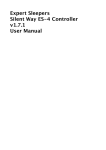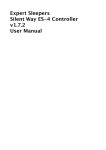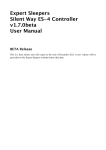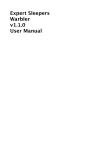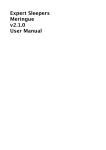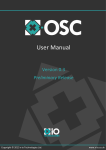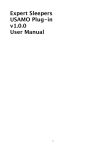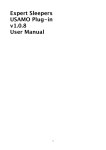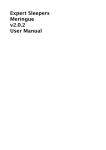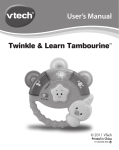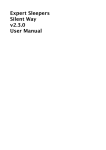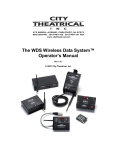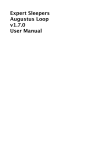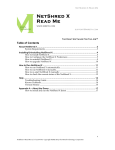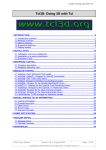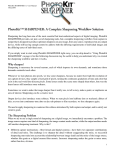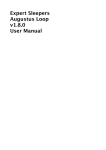Download Expert Sleepers Little Spacey v1.1.0 User Manual
Transcript
Expert Sleepers Little Spacey v1.1.0 User Manual Copyright © 2009-2013 Expert Sleepers. All rights reserved. This manual, as well as the software described in it, is furnished under licence and may be used or copied only in accordance with the terms of such licence. The content of this manual is furnished for informational use only, is subject to change without notice, and should not be construed as a commitment by Expert Sleepers. Expert Sleepers assumes no responsibility or liability for any errors or inaccuracies that may appear in this document. THE SOFTWARE IS PROVIDED "AS IS", WITHOUT WARRANTY OF ANY KIND, EXPRESS OR IMPLIED, INCLUDING BUT NOT LIMITED TO THE WARRANTIES OF MERCHANTABILITY, FITNESS FOR A PARTICULAR PURPOSE AND NONINFRINGEMENT. IN NO EVENT SHALL THE AUTHORS OR COPYRIGHT HOLDERS BE LIABLE FOR ANY CLAIM, DAMAGES OR OTHER LIABILITY, WHETHER IN AN ACTION OF CONTRACT, TORT OR OTHERWISE, ARISING FROM, OUT OF OR IN CONNECTION WITH THE SOFTWARE OR THE USE OR OTHER DEALINGS IN THE SOFTWARE. Contents Introduction 6 Installation 7 Mac OS X, Audio Unit (AU)! Mac OS X, VST! Windows (VST)! 7 7 7 System Requirements 7 Mac OS X! Windows! 7 7 Registration 8 Quickstart 9 Factory presets 9 Defaults! With Feedback! Subtle Shimmer! Vibrato! Oil Drum! Stereo Delay! Two LFOs! Ducky! Env Mod Depth! Env Mod Speed! Murky Swirl! Bright Slap! So Dark! Hard Crush! Deep Crush! 9 9 9 9 9 9 9 9 10 10 10 10 10 10 10 Using Little Spacey Using the controls Knobs! Sliders! Dropdown menus! Value edit boxes! 11 11 11 11 11 11 Name/value display! Delay Time Delay! Spread! Size! Regeneration Feedback! Path! Colour! Mix Mix! Dry Mix! Mod Depth Depth! Spread! Mod Speed Speed! Envelope Modulation Ducking! Speed! Depth! Spread! LFO 2 Speed! Depth! Spread! Preferences 11 12 12 12 12 13 13 13 13 13 13 13 14 14 14 14 14 14 15 15 15 15 15 15 15 15 16 OSC Base Port! Eye candy! Constant redraw! Floating tooltip! 16 16 16 16 MIDI control 17 OSC Control 18 Reference MIDI & OSC Scripting 18 18 Reference 18 Script locations 18 Version History 19 Contact 20 Acknowledgements 21 Lua 21 oscpack 21 glew 22 FreeType 23 FTGL 23 libpng 23 zlib 23 Introduction Little Spacey is delay effect, inspired by classic analogue ‘bucket brigade’ delays but with refinements only possible in the digital arena - not to mention a maximum delay time that would cost a small fortune to realise in hardware. Great care has been taken to give Little Spacey the smooth, creamy sound which makes analogue delays still popular today. In common with the best analogue delays Little Spacey allows you to modulate the delay time for chorus or vibrato effects. Unlike most analogue delays, Little Spacey is not restricted to mono operation, and works well in stereo or multi-channel (AU only) settings, offering variation of the effect between the channels for particularly rich and involving sounds. Installation Mac OS X, Audio Unit (AU) The plug-in file is called ExSlLittleSpacey.component. Simply copy the file to the folder: Library/Audio/Plug-Ins/Components Mac OS X, VST The plug-in file is called ExSlLittleSpacey.vst. Simply copy the file to the folder: Library/Audio/Plug-Ins/VST Windows (VST) The plug-in file is called littlespacey.dll. Simply copy the file to your VST plug-ins folder. System Requirements Mac OS X Little Spacey requires at least Mac OS X version 10.6.8. The plug-in is Intel-only, and built for both 32 and 64 bit. The Audio Unit version will work in any Audio Unit host. The VST version requires a “VST 2.4” compatible host.1 Windows Little Spacey has been developed and tested with Windows XP SP2 and Windows 7. It may work with other versions of Windows (Vista included) but this is by no means guaranteed. The plug-in requires a “VST 2.4” compatible host. 1 VST is a trademark of Steinberg Media Technologies GmbH. Registration The downloadable version of Little Spacey stops working after 15 minutes every time you use it. To stop this happening, you need to buy a registration. You can buy a registration key online using a credit card or PayPal from the Expert Sleepers Licence Manager application. See here for more information. Note that you need at least version 1.0.14 of the Licence Manager. The e-commerce side of things is handled by eSellerate. If you have any security concerns, have a look at their website which is pretty informative. Your registration key allows you to install Little Spacey on up to 3 different computers (useful if for example you have a desktop computer in the studio and a laptop for live use). You need an internet connection to activate the software, though not necessarily on the computer on which you want to use it. Quickstart For a quick overview of Little Spacey, load up the plug-in in your host application of choice and try out the factory presets, which are listed below. In some cases you will probably need to set up your levels appropriately, as described below in the Envelope Modulation section, so that the envelope tracking works optimally. Factory presets Defaults In this preset all parameters are at their default value, giving a single fairly short delay. This is a plain ‘vanilla’ preset from which to start creating your own sounds. With Feedback Adds some feedback to the default settings for a repeating echo. Subtle Shimmer Adds some modulation, with spread, for a rich ‘chorus-y’ sound. Vibrato A deeper modulation, with a very short (almost inaudible) delay, turns the effect into more of a vibrato than a delay per se. Oil Drum A tiny delay with high feedback gives what sounds a little like a reverb, but in a highly coloured environment. Stereo Delay The spread on the delay time is turned up to give quite different delay times on the left and right channels. Two LFOs LFO 2 applies a modulation to the LFO 1 modulation depth. LFO 2 Spread is set to 0.5 so left and right channels are out phase. Ducky Maximum ducking is applied. With an appropriate input level you should hear that the delays are inaudible when the incoming sound is loud, only appearing when the level tails off. This effect is typically used to let the initial note ‘cut through’ the delays, with the delays then fading up during the note’s decay tails. Env Mod Depth Negative envelope depth modulation is applied, so there is very little modulation when the sound is loud, but the modulation increases as the sound fades out. Env Mod Speed Envelope speed modulation means the modulation gets slower as the incoming sound fades out. Murky Swirl A composite effect, offering dark delays with a slow swirl from the modulation section. Bright Slap The inner feedback path is used to brighten up the delay. So Dark The colour is wound down to Infra-Red and the dry mix is set to Filtered for a maximally dark sound. Hard Crush 110% feedback and inner feedback path make for a grungy noise. Deep Crush As Hard Crush but with outer feedback for a dark, dark wub. Using Little Spacey Using the controls Knobs Basic use of the knobs is to click on them and drag the mouse up and down. However you can obtain different results by holding keys as follows: • • • Shift : Values change more slowly as you move the mouse. Command1 (Mac OS X)/Alt (Windows) : The knob assumes its default position. Option 2 (Mac OS X)/Control (Windows): The knob assumes integer values only. Sliders Sliders behave similarly. • • Shift : Values change more slowly as you move the mouse. Command : The slider assumes its default position. Dropdown menus Clicking on the menu displays the list of options. Move the mouse over the desired option and release the mouse to select it. Value edit boxes These boxes (below each knob and slider) let you enter parameter values directly. Clicking on the value highlights it in green - you can then type the desired value using the keyboard. Press enter to finish and accept the new value. While you’re typing the value, the box goes red to indicate that the value you see has not yet been accepted. Name/value display As you move the mouse around the interface, the name and current value of the control currently under the mouse is displayed in the top right of the window. This area also provides tool-tips for buttons. 1 The ‘Command’ key is also known as the ‘Apple’ key - the one next to the spacebar. 2 The ‘Option’ (alt) key is the one between the Control (ctrl) key and the Command (cmd) key. Delay Time The Delay Time section controls the length of the delay. Delay Sets the length of the delay within the limits set with the Size control. The value simply goes from 0.0 to 1.0. Refer to the read-out at the bottom of the section for the actual delay time in milliseconds. Spread Sets the difference in delay times between the channels (i.e. left and right for stereo operation). At 0.0, the two channels have the same delay time. Size Sets the maximum length of the delay - the length of the ‘bucket brigade’ in hardware terms. The actual maximum delay time will depend on this setting and on your audio clock rate. E.g. at 88.2kHz the delays will be exactly half as long as at 44.1kHz. The range of delay times at 44.1kHz is as follows: Size setting Minimum delay time Maximum delay time Tiny 5.8ms 116.1ms Small 11.6ms 232.2ms Comfortable 23.2ms 464.3ms Large 46.4ms 928.8ms Very Large 92.9ms 1857.6ms Huge 185.8ms 3715.2ms Regeneration The Regeneration section controls how the delay repeats. Feedback Sets the amount of the delayed signal that gets routed back to the input of the delay, causing repeated echoes. Note that the control goes up to 110%. Settings above 100% cause ‘positive feedback’ i.e. the delays get louder over time. Path In common with all ‘bucket brigade’ designs, Little Spacey uses filters either side of the delay to remove aliasing and clock noise. The Path setting lets you control whether the feedback goes around the full signal path (including the filters) or just around the delay itself (not the filters). In practice this means that the ‘inner’ path gives a relatively bright delay while the ‘outer’ path tends to lose the top end off the delays much more quickly. Settings between ‘inner’ and ‘outer’ simply use a mixture of both feedback paths. Colour Allows you to lower the cut-off frequencies of the low pass filters, resulting in delays that lose more of their high frequency components. Mix The Mix section controls the relative levels of the delayed and original sounds. Mix The Mix settings is a simple cross-fade between the ‘dry’ sound (the un-delayed input to the plug-in) and the ‘wet’ sound (the delays themselves). Dry Mix Controls whether the ‘dry’ output is indeed the true dry sound or a filtered version. The filtered version can be useful when using fairly ‘dark’-sounding delays to match the dry sound more closely to the delayed sound. Mod Depth The Mod Depth section controls the depth of the delay modulation. The delay time is modulated by a simple sinusoidal LFO (low frequency oscillator). Depth Sets the amount of modulation. Spread Varies the phase of the LFO applied to each (stereo) channel. At 0.0, the LFOs are in phase i.e. the same modulation is applied to each channel. At 0.5 the LFOs are exactly out of phase i.e the LFO for channel 1 is at its maximum when the LFO for channel 2 is at its minimum. The Spread setting is useful for creating ‘wide’-sounding effects from mono sources. Mod Speed The Mod Speed section controls the speed of the delay modulation. Speed Sets the frequency (in Hz i.e. cycles per second) of the delay modulation. Envelope Modulation The Envelope Modulation section controls the response of the plug-in to the envelope (i.e. the loudness) of the incoming sound. For these features to work effectively you should ensure that the signal level going into the plug-in is appropriate. Use the level meters - the signal should be peaking into the yellow area at least. Ducking Ducking reduces the level of the delays when the signal level is high. This is typically used to let the initial note ‘cut through’ the delays, with the delays then fading up during the note’s decay tails. Speed Sets the amount by which the envelope modifies the modulation speed. Positive settings cause the modulation to speed up when the sound is louder; negative settings cause the modulation to slow down when the sound is louder. Depth Sets the amount by which the envelope modifies the modulation depth. Positive settings cause the modulation depth to increase when the sound is louder; negative settings cause the modulation depth to decrease when the sound is louder. Spread Sets the amount by which the envelope modifies the modulation LFO’s spread. LFO 2 The LFO 2 section lets you control a second LFO which modulates the depth of the main modulation LFO. Speed Sets the speed of the second LFO. Depth Sets the amount by which the second LFO affects the depth of the main LFO. Spread Varies the phase of the second LFO applied to each (stereo) channel. Preferences Pressing the ‘Prefs’ button brings up a dialog where various preferences are set. These settings are shared by all instances of Little Spacey, and are not stored with presets. The top section shows the product version. The central section will show your serial number once you’ve bought a registration. OSC Base Port Sets the base port number for OSC. See the section on OSC, below. Eye candy Enables the pretty graphics. Turn off if you don’t like them, or if your computer has compatibility issues with drawing such things. Constant redraw Is on by default. If turned off, the GUI is only redrawn when a control changes. Use this if you’re concerned that the GUI is wasting your CPU resources. Note that the display of tracked pitch and envelope is useless if constant redraw is disabled. Floating tooltip Causes the parameter name and value display (usually in the top right of the GUI) to be displayed above the mouse pointer. MIDI control All of Little Spacey’s parameters can be controlled via MIDI CC’s (Continuous Controllers) according to the table below. 0! 2! 3! 4! 5! 8! 9! 11! 12! 13! 14! 15! 16! 17! 18! 19! 20! 21! 22! Mix Dry Mix Size Delay Time Spread Feedback Feedback Path Colour LFO 1 Speed LFO 1 Depth LFO 1 Spread LFO 2 Speed LFO 2 Depth LFO 2 Spread Ducking Env->LFO 1 Speed Env->LFO 1 Depth Env->LFO 1 Spread OSC Port Offset OSC Control Little Spacey can be controlled via the Open Sound Control (OSC) protocol. If you’re new to OSC, start by visiting opensoundcontrol.org. Two settings control what port the plug-in uses to listen on for OSC commands. One is the base OSC port, set in the preferences. The second is the OSC Port Offset control. If the port offset is set to something other than ‘Off’, then the two numbers are added together and the result used as the port number. E.g. if the base port is 6000 and the port offset is 1, then the plug-in will listen on port 6001. Reference All Expert Sleepers plug-ins that support OSC share a common implementation. This is documented in the ‘OSC Control Manual’, available from the Expert Sleepers website. MIDI & OSC Scripting It is possible to extend the plug-in’s MIDI & OSC functionality via user-writeable scripts. Indeed, the standard MIDI functionality described above has been re-implemented using such a script, which you can use as reference for your customisations. The language used for the MIDI scripts is Lua. You will find a complete description of the language, and some useful tutorials, at the Lua website: www.lua.org All the standard language features of Lua are available in the scripts, plus some extra functions specific to the Expert Sleepers system. Reference All Expert Sleepers plug-ins that support MIDI/OSC scripting share a common implementation. This is documented in a the ‘MIDI & OSC Scripting Manual’, available from the Expert Sleepers website. Script locations The plug-in name for constructing the script locations is ‘Little Spacey’. Version History 1.1.0 18/7/2013 • 64 bit AU version. 1.0.2 5/1/2010 • (Windows VST) Fixed a possible crash when opening the plug-in GUI on some low end graphics hardware. 1.0.1 6/10/2009 • Update for Mac OS X 10.6 compatibility. 1.0.0 21/5/2009 • ! First release. Contact The Expert Sleepers website is here: http://www.expert-sleepers.co.uk/ Or you can email [email protected] Or you can use the forum, which is here: http://www.kvraudio.com/forum/viewforum.php?f=85 Acknowledgements The software described in this manual makes use of the following open source projects. The author is greatly indebted to them for their efforts and generosity. Below are reproduced the various copyright notices and disclaimers that accompany these software projects, in accordance with their terms of use. Lua Copyright (C) 1994-2008 Lua.org, PUC-Rio. Permission is hereby granted, free of charge, to any person obtaining a copy of this software and associated documentation files (the "Software"), to deal in the Software without restriction, including without limitation the rights to use, copy, modify, merge, publish, distribute, sublicense, and/or sell copies of the Software, and to permit persons to whom the Software is furnished to do so, subject to the following conditions: The above copyright notice and this permission notice shall be included in all copies or substantial portions of the Software. THE SOFTWARE IS PROVIDED "AS IS", WITHOUT WARRANTY OF ANY KIND, EXPRESS OR IMPLIED, INCLUDING BUT NOT LIMITED TO THE WARRANTIES OF MERCHANTABILITY, FITNESS FOR A PARTICULAR PURPOSE AND NONINFRINGEMENT. IN NO EVENT SHALL THE AUTHORS OR COPYRIGHT HOLDERS BE LIABLE FOR ANY CLAIM, DAMAGES OR OTHER LIABILITY, WHETHER IN AN ACTION OF CONTRACT, TORT OR OTHERWISE, ARISING FROM, OUT OF OR IN CONNECTION WITH THE SOFTWARE OR THE USE OR OTHER DEALINGS IN THE SOFTWARE. oscpack oscpack -- Open Sound Control packet manipulation library http://www.audiomulch.com/~rossb/code/oscpack Copyright (c) 2004 Ross Bencina <[email protected]> Permission is hereby granted, free of charge, to any person obtaining a copy of this software and associated documentation files (the "Software"), to deal in the Software without restriction, including without limitation the rights to use, copy, modify, merge, publish, distribute, sublicense, and/or sell copies of the Software, and to permit persons to whom the Software is furnished to do so, subject to the following conditions: The above copyright notice and this permission notice shall be included in all copies or substantial portions of the Software. Any person wishing to distribute modifications to the Software is requested to send the modifications to the original developer so that they can be incorporated into the canonical version. THE SOFTWARE IS PROVIDED "AS IS", WITHOUT WARRANTY OF ANY KIND, EXPRESS OR IMPLIED, INCLUDING BUT NOT LIMITED TO THE WARRANTIES OF MERCHANTABILITY, FITNESS FOR A PARTICULAR PURPOSE AND NONINFRINGEMENT. IN NO EVENT SHALL THE AUTHORS OR COPYRIGHT HOLDERS BE LIABLE FOR ANY CLAIM, DAMAGES OR OTHER LIABILITY, WHETHER IN AN ACTION OF CONTRACT, TORT OR OTHERWISE, ARISING FROM, OUT OF OR IN CONNECTION WITH THE SOFTWARE OR THE USE OR OTHER DEALINGS IN THE SOFTWARE. glew The OpenGL Extension Wrangler Library Copyright (C) 2002-2007, Milan Ikits <milan ikits[]ieee org> Copyright (C) 2002-2007, Marcelo E. Magallon <mmagallo[]debian org> Copyright (C) 2002, Lev Povalahev All rights reserved. Redistribution and use in source and binary forms, with or without modification, are permitted provided that the following conditions are met: * Redistributions of source code must retain the above copyright notice, this list of conditions and the following disclaimer. * Redistributions in binary form must reproduce the above copyright notice, this list of conditions and the following disclaimer in the documentation and/or other materials provided with the distribution. * The name of the author may be used to endorse or promote products derived from this software without specific prior written permission. THIS SOFTWARE IS PROVIDED BY THE COPYRIGHT HOLDERS AND CONTRIBUTORS "AS IS" AND ANY EXPRESS OR IMPLIED WARRANTIES, INCLUDING, BUT NOT LIMITED TO, THE IMPLIED WARRANTIES OF MERCHANTABILITY AND FITNESS FOR A PARTICULAR PURPOSE ARE DISCLAIMED. IN NO EVENT SHALL THE COPYRIGHT OWNER OR CONTRIBUTORS BE LIABLE FOR ANY DIRECT, INDIRECT, INCIDENTAL, SPECIAL, EXEMPLARY, OR CONSEQUENTIAL DAMAGES (INCLUDING, BUT NOT LIMITED TO, PROCUREMENT OF SUBSTITUTE GOODS OR SERVICES; LOSS OF USE, DATA, OR PROFITS; OR BUSINESS INTERRUPTION) HOWEVER CAUSED AND ON ANY THEORY OF LIABILITY, WHETHER IN CONTRACT, STRICT LIABILITY, OR TORT (INCLUDING NEGLIGENCE OR OTHERWISE) ARISING IN ANY WAY OUT OF THE USE OF THIS SOFTWARE, EVEN IF ADVISED OF THE POSSIBILITY OF SUCH DAMAGE. Mesa 3-D graphics library Version: 7.0 Copyright (C) 1999-2007 Brian Paul All Rights Reserved. Permission is hereby granted, free of charge, to any person obtaining a copy of this software and associated documentation files (the "Software"), to deal in the Software without restriction, including without limitation the rights to use, copy, modify, merge, publish, distribute, sublicense, and/or sell copies of the Software, and to permit persons to whom the Software is furnished to do so, subject to the following conditions: The above copyright notice and this permission notice shall be included in all copies or substantial portions of the Software. THE SOFTWARE IS PROVIDED "AS IS", WITHOUT WARRANTY OF ANY KIND, EXPRESS OR IMPLIED, INCLUDING BUT NOT LIMITED TO THE WARRANTIES OF MERCHANTABILITY, FITNESS FOR A PARTICULAR PURPOSE AND NONINFRINGEMENT. IN NO EVENT SHALL BRIAN PAUL BE LIABLE FOR ANY CLAIM, DAMAGES OR OTHER LIABILITY, WHETHER IN AN ACTION OF CONTRACT, TORT OR OTHERWISE, ARISING FROM, OUT OF OR IN CONNECTION WITH THE SOFTWARE OR THE USE OR OTHER DEALINGS IN THE SOFTWARE. Copyright (c) 2007 The Khronos Group Inc. Permission is hereby granted, free of charge, to any person obtaining a copy of this software and/or associated documentation files (the "Materials"), to deal in the Materials without restriction, including without limitation the rights to use, copy, modify, merge, publish, distribute, sublicense, and/or sell copies of the Materials, and to permit persons to whom the Materials are furnished to do so, subject to the following conditions: The above copyright notice and this permission notice shall be included in all copies or substantial portions of the Materials. THE MATERIALS ARE PROVIDED "AS IS", WITHOUT WARRANTY OF ANY KIND, EXPRESS OR IMPLIED, INCLUDING BUT NOT LIMITED TO THE WARRANTIES OF MERCHANTABILITY, FITNESS FOR A PARTICULAR PURPOSE AND NONINFRINGEMENT. IN NO EVENT SHALL THE AUTHORS OR COPYRIGHT HOLDERS BE LIABLE FOR ANY CLAIM, DAMAGES OR OTHER LIABILITY, WHETHER IN AN ACTION OF CONTRACT, TORT OR OTHERWISE, ARISING FROM, OUT OF OR IN CONNECTION WITH THE MATERIALS OR THE USE OR OTHER DEALINGS IN THE MATERIALS. FreeType The FreeType Project is copyright (C) 1996-2000 by David Turner, Robert Wilhelm, and Werner Lemberg. THE FREETYPE PROJECT IS PROVIDED `AS IS' WITHOUT WARRANTY OF ANY KIND, EITHER EXPRESS OR IMPLIED, INCLUDING, BUT NOT LIMITED TO, WARRANTIES OF MERCHANTABILITY AND FITNESS FOR A PARTICULAR PURPOSE. IN NO EVENT WILL ANY OF THE AUTHORS OR COPYRIGHT HOLDERS BE LIABLE FOR ANY DAMAGES CAUSED BY THE USE OR THE INABILITY TO USE, OF THE FREETYPE PROJECT. FTGL Copyright (C) 2001-3 Henry Maddocks Permission is hereby granted, free of charge, to any person obtaining a copy of this software and associated documentation files (the "Software"), to deal in the Software without restriction, including without limitation the rights to use, copy, modify, merge, publish, distribute, sublicense, and/or sell copies of the Software, and to permit persons to whom the Software is furnished to do so, subject to the following conditions: The above copyright notice and this permission notice shall be included in all copies or substantial portions of the Software. THE SOFTWARE IS PROVIDED "AS IS", WITHOUT WARRANTY OF ANY KIND, EXPRESS OR IMPLIED, INCLUDING BUT NOT LIMITED TO THE WARRANTIES OF MERCHANTABILITY, FITNESS FOR A PARTICULAR PURPOSE AND NONINFRINGEMENT. IN NO EVENT SHALL THE AUTHORS OR COPYRIGHT HOLDERS BE LIABLE FOR ANY CLAIM, DAMAGES OR OTHER LIABILITY, WHETHER IN AN ACTION OF CONTRACT, TORT OR OTHERWISE, ARISING FROM, OUT OF OR IN CONNECTION WITH THE SOFTWARE OR THE USE OR OTHER DEALINGS IN THE SOFTWARE. libpng http://www.libpng.org/pub/png/libpng.html zlib http://www.zlib.net/























